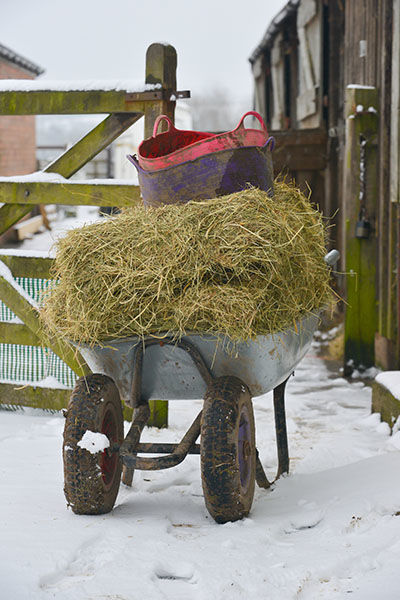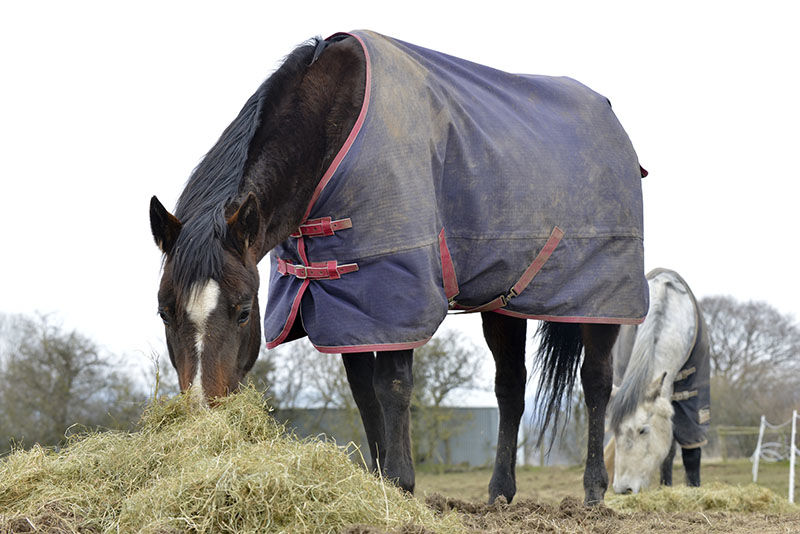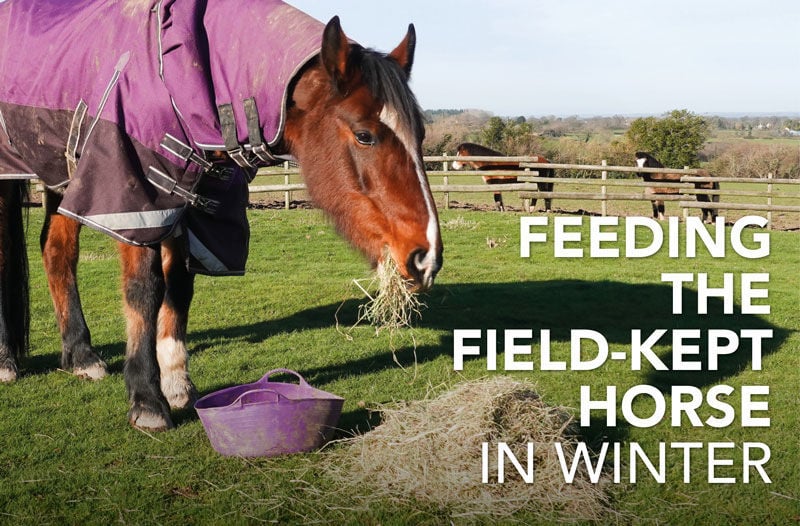As the nights start to draw in many of us start to look ahead to winter and what we will be feeding our horses. Whilst most horses are stabled for some of the time over the winter months, there are many that live out 24/7 all year round. Hotchkiss et al. (2007) surveyed 1431 horse owner to investigate the care and management of horses kept in Great Britain. This study revealed that, out of the horses included in the survey, just over 25% of them had 24/7 winter turnout. A lot of winter-feeding advice focuses on how to support the stable kept horse so this article will address the main feeding practises we recommend for the field kept horse over winter.
Forage
Forage should form the foundation of any horse’s diet. Grass kept horses will eat for approximately 16 hours per day (Glunk et al. 2013) and this forage intake helps to maintain optimal digestive health, as well as supporting natural trickle feeding behaviours. Over the winter months grass quality and quantity declines meaning it is often necessary to supplement the horse’s diet with additional sources of long stem forage, such as hay or haylage. It is recommended that horses receive no less than 1.5% of their bodyweight in dry weight forage per 24-hour period, but this should be increased to 2 – 2.5%, or ideally ad-lib for horses that do not require weight loss. As a guide this would mean that a 550kg horse should receive a minimum of 8.25kg - 13.75kg of hay in a 24-hour period.
TOP TIP – if your horse lives out with other horses ensure there is enough hay or haylage for all the horses in the field to avoid fighting and resource guarding. There should always be at least one more source of forage compared to the number of horses in the field, for example if there are 3 horses in the field place out a minimum of 4 piles of hay.

Forage also plays a vital role in helping to keep the grass kept horse warm during the winter months. Horses have a much larger thermoneutral zone (TNZ) compared to humans. The TNZ defines the range in temperature where the horse can regulate its body temperature with little or no energy expenditure (Christopherson and Young, 1986). A mature horse's average TNZ ranges from 5°C to 25°C for horses living in mild climates (Morgan, 1998). When temperatures drop below 5°C the horse must expend energy in order to keep warm (McBride et al. 1985; Morgan, 1998). It is important to note that rainy and windy weather conditions also increase the horse’s requirement to expend energy to keep warm. Studies have shown that horses will seek out shelter in temperatures above 5°C if the weather is rainy and/or windy (Mejdell et al. 2005; Jørgenses et al. 2016).
Other factors that can affect thermoregulation include breed, age, body condition, size, and health condition. Each horse is unique and must be treated as an individual.
One of the ways we can help our horses to keep warm over the winter months in low temperatures and/or wet and windy weather is to provide plenty of forage. Forage is digested in the large intestine by microbes and one of the by-products of this digestion is metabolic heat. This heat helps to keep the horse warm from the inside out, thereby supporting thermal comfort (Santos et al. 2011). Harper et al. (2004) estimates that an additional of 10 - 15% good quality forage should be fed when temperatures drop below freezing (0°C).

Hard feed
Hard feed can be used to further boost the horse’s fibre intake, as well as the calories they are consuming. Feeds such as chaff, chopped grass, soaked sugarbeet and fibre cubes are excellent products to use over the winter months. Highly digestible fibre sources, sometimes known as “super-fibres” include sugarbeet, soya hulls and alfalfa. These fibre sources are much more digestible compared to other fibre sources, for instance, sugarbeet has a digestibility of 80%, compared to hay which has a digestibility of 40 - 50% (Brown-Douglas, 2011). A higher digestible energy level means the horse can get more calories from these fibre sources, compared to the calories they receive from hay.
Ensuring optimal vitamin and mineral intake is important all year round, but especially in winter when horses are likely to be fed a high level of conserved forages which have lower nutrient profiles compared to growing grass (Carter, 1960; Macdonald and Clark, 1987). A good vitamin & mineral profile will support general health and well-being as well as supporting good hoof, skin and hair quality, something vital for horses living out over winter.
The skin is the largest organ of the horse’s body and its job it to protects the body from harmful environmental factors, such as weather changes and injury. A balanced diet with optimum levels of Zinc, Copper and Biotin will support skin health from within. A study by Jancikova et al. (2012) found that that supplementing horse’s diets with zinc & copper improved both hoof and hair growth over a 9-month period compared to horses fed a control diet.
To further support skin health, it is recommended to add additional Omega-3 fatty acids to the diet of horses living out over winter. Cell membranes, including skin cells, contain omega 3 fatty acids and these help to increase the elasticity and suppleness of the skin cells, helping to maintain optimal condition (Stark et al. 2016). Omega 3 fatty acids also help to nourish hair follicles, supporting healthy growing hair and therefore improvement coat condition. In addition, Omega-3 fatty acids are known for their anti-inflammatory properties, with a correct ratio of Omega-3:Omega-6 fatty acids being highly beneficial for skin conditions, especially in acute or chronic inflammatory cases (Geor et al. 2013). Adding additional Omega 3 fatty acids to the diet will support overall skin health and is especially important for horses prone to skin conditions, such as mud fever.
Hydration
The accepted water requirement for horses is around 60ml/kg/day (Freeman, 2021), which works out a 30L of water for an average 500kg horse. Spring and summer grass has moisture levels of approximately 60 - 80%, which greatly contributes to the horse’s water intake. In contrast conserved forages, such as hay, contain less than 15% moisture and so poorly contribute to the horse’s daily water intake (Cymbaluk, 2013). Water is necessary for maintaining moisture levels in the horse’s gastrointestinal system and a decrease in water consumption causes ingesta to dry up, increasing the risk of impaction colic or intestinal blockage (Bihonegn, 2018). Horses tend to drink less water throughout the winter months and it is therefore essential to observe their water intake and encourage them to drink to maintain hydration and reduce the risk of colic.
Kristula et al. (1994) performed a study consisting of two trials to compare consumption of near-freezing water (ranged from 0°C to 1°C) and warm water (46°C to 49°C) by 14 ponies. The study concluded that on average, ponies drank 40% more warm water compared to near-freezing water., with most water consumption occurring when the water was 20°C to 35°C. Based on this study, providing warm water for horses is likely encourage them to drink and help maintain hydration levels.
Another factor to consider in the winter months is that low temperatures encourage water to freeze so water troughs and buckets should be checked at least twice a day to break and remove any ice if water supply has frozen.
In summary
In summary when feeding your grass kept horse over winter remember to ensure you are feeding a minimum of 1.5% of your horse’s bodyweight in forage, use “Super-Fibres” to provide additional calories, and ensure your horse is keeping well hydrated and you are feeding a nutritionally balanced diet.
For any advice or questions you may have, please don't hesitate to reach out to our expert nutrition team. You can call 0800 585525 Monday-Friday 8:30am-5:00pm. Email [email protected], or send us a DM on social media.
References
- Bihonegn, T., & Bekele, F. (2018). ‘Colic in Equine: A Review Article’, International Journal of Advanced Research in Biological Sciences’, 5(5), pages 185-192.
- Brown-Douglas, c. (2011) ‘Beet Pulp: The Ultimate Fibre for Horses’ Available at: https://ker.com/equinews/beet-pulp-ultimate-fibre-horses/?highlight=super%20fibres
- Carter, W.R.B. (1960) ‘A review of nutrient losses and efficiency of conserving herbage as silage, barn‐dried hay and field‐cured hay’, Grass and Forage Science, 15(3), pages 220-230.
- Christopherson, R. J., and Young, B. A. (1986). ‘Effect of cold environments on domestic animals. In: Grazing Research at Northern Latitudes’, ed. 0. Gudmundsson. Nato AS1 Series, pp. 247-257. Plenum Press, New York.
- Cymbaluk, N. (2013). ‘Water’, In: Geor, R.J., Harris, P.A., & Coenen, M. (eds.). Equine Applied and Clinical Nutrition. Saunders Elsevier: China.
- Freeman, D. (2021). ‘Effect of Feed Intake on Water Consumption in Horses: Relevance to Maintenance Fluid Therapy’, Frontiers in Veterinary Science, 8: pages 1-7.
- Geor, R., Harris, P., & Coenen, M. (2013) ‘Equine Applied and Clinical Nutrition’. 1st ed. Edinburgh: Elsevier.
- Glunk, E.C., Weber, W.J. and Martinson, K.L. (2013). ‘The effect of hay net design on rate and amount of forage consumed by adult horses’.
- Harper, F. (2004). ‘Winter Horse Feeding. Extension Horse Specialist Department of Animal Science’, 23(1).
- Hotchkiss, J.W., Reid, S.W.J. and Christley, R.M., 2007. ‘A survey of horse owners in Great Britain regarding horses in their care. Part 1: Horse demographic characteristics and management’, Equine Veterinary Journal, 39(4), pages 294-300.
- Jancikova, P., Horký, P. and Zeman, L., 2012. ‘The effect of feed additive containing vitamins and trace elements on the elements profile and growth of skin derivatives in horses’, Annals of Animal Science, 12(3), page 381.
- Jørgensen, G., Aanensen, L., Mejdell, C., & Bøe, K. (2016). ‘Preference for shelter and additional heat in horses exposed to Nordic winter conditions. Equine Veterinary Journal’, 48(6), pages 720-726.
- Kristula, M., & McDonnell, S. (1994). ‘Drinking water temperature affects consumption of water during cold weather in ponies’, Applied Animal Behaviour Science, 41(3-4), pages 155-160.
- Macdonald, A.D. and Clark, E.A. (1987) ‘Water and quality loss during field drying of hay’, Advances in agronomy, 41, pages 407-437.
- McBride, G., Christopherson, R., & Sauer, W. (1985). ‘Metabolic rate and plasma thyroid hormone concentrations of mature horses in response to changes in ambient temperature’, Canadian Journal of Animal Science, 65(2), pages 375-382.
- Mejdell, C., & Bøe, K. (2005). ‘Responses to climatic variables of horses housed outdoors under Nordic winter conditions’, Canadian Journal of Animal Science, 85(3), pages 301-308.
- Morgan, K. (1998). ‘Thermoneutral zone and critical temperatures of horses’, Journal of Thermal Biology, 23(1), pages 59-61.
- Santos, A., Rodrigues, M., Bessa, R., Ferreira, L., & Martin-Rosset, W. (2011). ‘Understanding the equine cecum-colon ecosystem: current knowledge and future perspectives’, Animal, 5(1), pages 48-56.
- Stark, A.H., Reifen, R. and Crawford, M.A. (2016) ‘Past and present insights on alpha-linolenic acid and the omega-3 fatty acid family’, Critical reviews in food science and nutrition, 56(14), pages 2261-2267.


